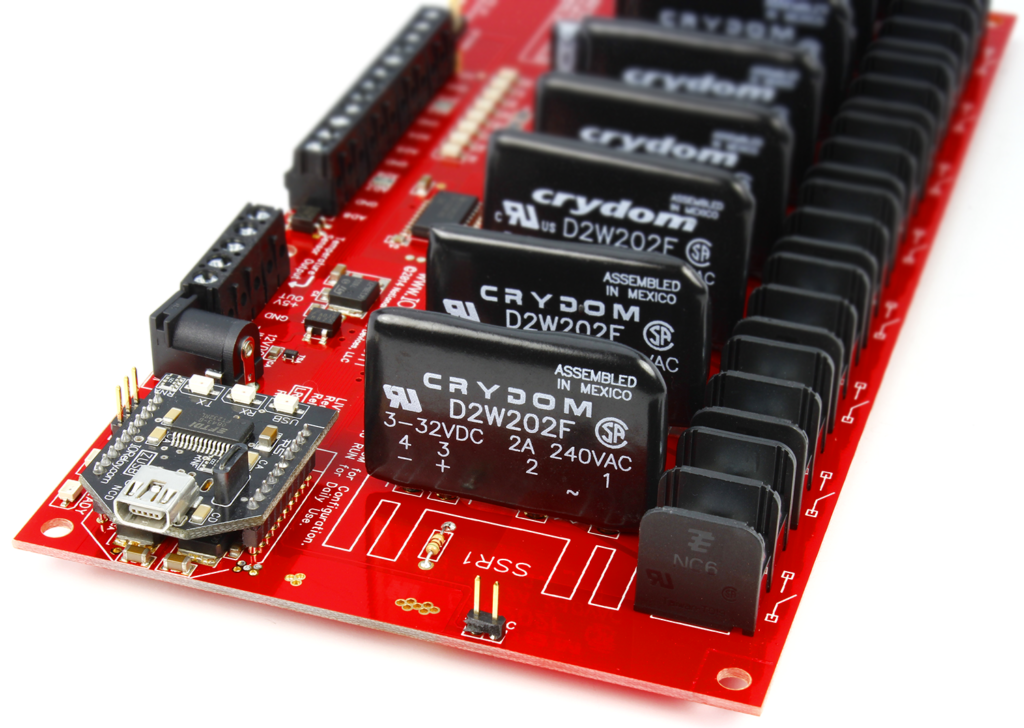Reactor - Sensor Activated Relays
Features
Reactor Relays make it simple to activate relays based on sensory information. No Code, No Hassle.
- Works Without a Computer
- 8 Analog Inputs Trigger Relays Based on User Configuration
- 8 Available Timers Offer Time Delay Functions
- Inputs may Directly Trigger Relays
- Inputs may Directly Trigger Events Such as Timers
- 4 Rotation Counters Trigger Relays Based on Counting Values
- Use a Computer to Take Control of the Reactor Logic or to Return Control to Stand-Alone Operation
- Built-In Temperature Sensor on 4 & 8 Channel Models

Reactor Relays
The Reactor Relay controllers represent the worlds first relay controller capable of making its own intelligent decisions based on user input. The Reactor Relay Series controllers are configured using our custom Reactor Configuration Utility. Once configured, the controller works without a computer connected, allowing analog inputs to trigger relays according to the configuration. The Reactor Relay was developed to address the needs of customers who need a controller capable of making intelligent decisions without a computer. Once configured, the Reactor will work on its own. At any time, a remote computer may read analog inputs and take control of the relays. The remote computer can later return control back to the Reactor logic.
Why Choose NCD?
With NCD you know you have a proven reliable, easy to use, and extensible product because we’ve been in the business for over 20 years. This means you don’t have to spend valuable time researching how to jig-saw pieces of your project together to get them to work cohesively. Being manufactured in the U.S.A. you know you’ll get good support and a quality product. NCD also ensures you won’t have to put any time into soldering or building a PCB, just pick your boards and power them up. Knowing that every sensor, relay controller, and component is built around the same concept will save you guess work on how well software will work with any board.
How It Works
The Reactor controller must be configured using a computer and the included software. All decisions are made based on your configuration settings. Configuration settings are created and loaded into the Reactor controller using the NCD Configuration Utility. The Reactor is usually configured using a USB communications module, but may be configured wirelessly. Configuration is a simple Point and Click process, setting parameters to activate relays with user-defined limits.
Once configured, the Reactor CPU is constantly monitoring external sensors using 8 analog inputs. Inputs can be configured to trigger relays, relay timers and relay activation sequences. Complex events can also be configured without any programming. Use the Reactor as a Thermostat, a Motion Activated Light with a Programmable Timer, an Automatic Garage Door Closer, and much more.
Communication Options
Selecting a Communication Technology
The Communication Technology you choose will dictate how you will control and monitor the board. If you want to monitor over a LAN or WAN you can choose WiFi, Ethernet, or Web-i. Need wireless control? Choose S3B, Bluetooth, 802.15.4, or ZigBee Mesh. Want Reliable Wired communication? Choose USB, Serial, or RS-485.
The choice is yours and can change to suit your application.
WiFi Relays
Much of our development work was done with embedded Wi-Fi. Put simply, we adore this technology and we think you will too. Configuration requires careful attention to our instructions, but once configured…wow. It’s simply amazing and holds so much promise for future development work.
Bluetooth Relays
We offer Bluetooth communications because of its popularity with mobile devices. If you want to control relays with your smartphone (and you are savvy at writing such an application), then Bluetooth is the ideal choice. iPhone, iPad, and iPod developers should be warned, Apple iOS devices encrypt the Bluetooth protocol deliberately, so our Bluetooth interface is compatible with every computer ever made, including Android, PCs (and every version of Windows that supports Bluetooth), and Linux (and all variants thereof that support Bluetooth), but it will NEVER work with Apple iOS devices.
802.15.4 Relays
This is one of our favorite wireless technologies. It is easy to setup and use and very reliable. You need a 802.15.4 modem that plugs into your USB port to talk any number of 802.15.4 Wireless relays with up to 1 mile range! You can purchase a modem with the device you choose.
Key Fob Relays
Our 2nd generation Key Fob Series controllers allow users to control relays from a hand-held remote up to 750 feet away! Configure buttons to toggle relays, turn relays on and off, activate timers and control relay flashers. Integrated security features prevent unauthorized operation while maintaining easy configuration. Pair up to 40 different Key Fob remotes to a single controller.
Serial Relays
Serial communications may seem like old hat, but they’re also one of the most reliable and proven communication protocols available and are in fact the basis of most of the other communication options here.
You can choose between a Serial DB9 Connector or a 3 wire terminal connector for simple wire hookups. DB9 is the standard serial connector while the 3 wire terminal is usually more advanced and for existing ECM’s and serial splicing applications.
USB Relays
When it comes to ease of use, USB can’t be beat. With the reliability of Wired Communications and the pure simplicity of USB Technologies this is one of our most popular interface technologies.
To use USB simply plug it in to your computer/ECM, the driver should automatically be installed or already be installed, and open a COM/Serial Port to it. We use an industry standard FTDI chip for added reliability and compatibility across all Operating Systems.
Ethernet Relays
Ethernet communications combine the reliability of a wired connection with the power of network communications. Control your devices reliably from anywhere in the world by implementing a simple socket directly to the device.




